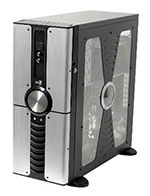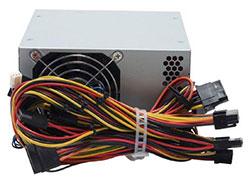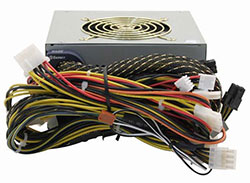Buyer's Guide: Mid-Range to High-End, May 2005
by Jarred Walton on May 23, 2005 5:30 PM EST- Posted in
- Guides
Case and Power Recommendations
Once you have all the internal parts picked out, it's time to find a home for your computer. This is often one of the most difficult decisions to make, as the case is what you'll actually see on a regular basis. If you're not worried about what the case looks like, you can probably get just about any cheap case at your local store. If you want something larger, smaller, flashier, quieter, etc., there is a case to fit your needs. Prices start at about $30 for the cheapest models (forget about the included power supplies!) and go all the way up to hundreds of dollars. We'll give a basic recommendation and a flashier alternative, but if you're looking for a truly exotic case, you're on your own. Well, maybe not quite on your own, but you get the idea.The power supply is a component that often gets overlooked, and for a modern system, we recommend spending a decent amount of money on a high quality power supply. The days of using the included "free" PSU are over for all but the lowest end computers. Sure, that 500W PSU might work well for a few weeks or months, but if you start experiencing system crashes and random instability, a low grade PSU - often with exaggerated performance characteristics - is a prime culprit. Generally speaking, you get what you pay for, so if a recognized name like Antec or Enermax is selling a 375W PSU for $40 and another manufacturer is claiming 500+ Watts for the same price, you should probably be suspicious at best.
Mid-Range Case Recommendation
Case: Antec SLK3000-B
Price: $56 Shipped
For good build quality at a relatively low price, Antec is always a safe bet. We're actually going to pull something of a cop-out and stick with an Antec SLK3000-B as our recommendation. It's nothing special in terms of looks, but it's reasonably quiet, affordable, and well designed. One 120mm fan is provided at the rear of the case with room for a second up front, and rails aid in the installation of hard drives and optical drives. About the only thing that you might find missing is front Firewire and audio ports, but that's not a major concern for most people. The SLK3700-BQE is a slightly more expensive model that does away with the CPU duct and the ventilation holes on the side panel while adding a 350W PSU. While we feel that most Mid-Range and higher PCs should have a better PSU, 350W ought to suffice for many people.
High-End Case Alternative
Case: AeroCool Spiral Galaxies
Price: $108 Shipped
This is definitely not a case for everyone, but we think that some people will really like it, so we're listing it as an option. It's a very large (full tower) case, so if that's not your style, look elsewhere. It does have some innovative features, like a wind tunnel to help keep the CPU cool. The wind tunnel has 120mm fans at the front and rear of the case, ensuring plenty of airflow; it's unfortunate that it doesn't provide air circulation for the GPU area as well, as SLI setups in particular could use some additional ventilation. The motherboard tray is reversed from the standard ATX design - it's on the left panel of the case - but while that's sort of like BTX, the design is still fully ATX compatible. The right panel has a case window with a honeycomb pattern on it (supposedly to reduce EMI), and the case has a door hiding the drive bays that can be locked if necessary. Another plus is the tool-less features for the fans and the expansion slots, and there are even rubber shock absorbers to help reduce noise from vibrations. Besides difference of opinion as to what looks cool, the only real problem is that getting the power cables from your PSU to reach all of the necessary areas can be difficult. If you go with a higher-end PSU, that usually isn't a problem, but you may not be able to determine whether or not a PSU will work until after you've purchased the parts. Overall, it's an interesting and innovative case design at a good price.
Mid-Range Power Supply
PSU: Antec SmartPower 2.0 400W
Price: $66 Shipped
While it is by no means the best power supply that you can find, Antec makes good quality units and provides a standard 3-year warranty for all their products. There are a few cheaper no-name brands that meet the new ATX 2.0 specification, but going with our above statement of prices being a decent indication of quality, we won't recommend a $45 500W ATX 2.0 PSU, as it simply sounds too good to be true. The 400W Antec model meets all the requirements of ATX 2.0, and the price matches up with the features. It has a 24-pin power connection for the motherboard as well as a 4-pin ATX12V adapter, one 6-pin PCIe power connection, two SATA power connections, four 4-pin molex adapters and a 4-pin floppy adapter. It also has dual 80mm fans to keep the internals cool, although that does cause it to create more noise than some other models.
The biggest complaint we have is that all of the cables are bare, meaning that there is no sheathing to make things look tidier. It doesn't really affect performance in any way, but if you have a case window, you might want something more attractive like an OCZ ModStream 450W. That runs about $25 more than the Antec and doesn't include dual 12V rails, but it does have a 24-pin power connector and you only need to plug in the cables that you're using. (The X-Connect Ultra, Antec NeoPower, AeroCool Turbine Power and probably several other PSUs have a similar design.) Fotron Source also makes a 500W PSU with sheathed cables that meets the ATX 2.0 spec, but it doesn't feature detachable cables. It might be a bit cheaper for comparable performance, but it still costs $90.
High-End Power Supply
PSU: Enermax EG565P-VE FMA2.0 SLI 535W
Price: $97 Shipped
For a high-end SLI system, you'll want to make sure that you have a very high quality power supply. The SmartPower 2.0 that we recommended above might be able to run such a setup as long as you didn't want more than one or two hard drives, but you're certainly pushing the limits of the PSU. A high powered graphics card like the 6800GT can easily draw 75W, so two of them running in SLI could use over 150W when gaming. Throw another 100W to the processor, and you've already used a sizeable chunk of the available power. We may have to look into the reliability of various PSUs in a future article, but for now, we would rather err on the side of caution, so we're going to go with power supplies in the 500W and higher range (or at least close to that). There are plenty of power supplies that still meet that requirement, including the 500W Antec SmartPower. However, since we're planning to use this in an SLI setup, what better way to guarantee proper support than to get an SLI certified PSU?
The Enermax Whisper II 2.0 (do you multiply to get 4.0?) has the relatively unique feature of including two 6-pin PCIe power connections. You also get the 24-pin and 12VATX connections for the motherboard, seven 4-pin molex plugs, two 4-pin floppy connections, and four SATA power adapters. The 535W of total power output should be more than sufficient for all but the most extreme configurations. The only real drawbacks are similar to that of the SmartPower. With the exception of the 24-pin cable, the cables aren't sheathed, so they look rather messy. You could sheath them yourself, but that's rather inconvenient.
If you're looking for other alternatives, there are quite a few PSUs that should work fine even with a high-end SLI configuration. Antec has their TruePower 2.0 units, Fotron Source and Seasonic are usually a good bet, and if you liked the alternative case recommendation, there's even a 550W AeroCool PSU that should work well. OCZ offers their ModStream, PowerWhisper and PowerStream units and they should all suffice, though the 600W PowerStream weighs in at a hefty $200+ price. Finally, Silverstone and CoolerMaster also have ATX 2.0 compliant power supplies that compare in price with the others in this list. You could probably get by with a power supply in the 400 to 450W range if you don't add too much other stuff to your system, but when you're talking about spending $700 or more just on graphics cards, we think that it's rather silly to try to save $10 or $20 on the power supply. It's a mistake that can come back to haunt you. It's better to have 150W more power than you need than to come up 25W short.














60 Comments
View All Comments
Calin - Tuesday, May 24, 2005 - link
Oh, and no micro ATX board is the flagship of any mainboard manufacturer. VIA is the only one that has a small mainboard as the flagship (the Mini ITX platform)Calin - Tuesday, May 24, 2005 - link
Hi TujanI think I would like to see more Micro ATX mainboards too. But the idea is that micro ATX boards are not in the segment that typical reviewers like. They usually lack any kind of overclocking potential, their expansion possibilities are very restricted, and in some cases the performance is lacking compared to their big brothers (ATX). Also, they usually have 2 memory slots (unlike 3 to 4 of ATX), and the layout is much more cramped.
Advantages? There could be a price advantage, size and maybe cooling.
JarredWalton - Tuesday, May 24, 2005 - link
crimson117 - Hey, I gave plenty of options for more RAM. The fact is there are very few people that really need more than 1GB of RAM right now. If you need more than 1GB, I'd probably go for 2x1GB rather than 4x512MB, as that gives you the option of upgrading to 4x1GB in the future. Still, 1GB DIMMs are expensive, so 4x512 isn't a terrible choice. Just realize that unless you really need more than 1GB of RAM, you'll end up with slightly slower performance, as none of the boards we've tested will run with 1T command rates and maximum timings when using four DIMMs.crimson117 - Tuesday, May 24, 2005 - link
If you go for the AMD board, I'd recommend getting 4x512mb ram.crimson117 - Tuesday, May 24, 2005 - link
It is a crime to limit such great systems with a mere 2x512mb of ram.KristopherKubicki - Tuesday, May 24, 2005 - link
arswihart: All motherboard manufacturers do that.Kristopher
arswihart - Tuesday, May 24, 2005 - link
that chaintech card is one of the best values in computer hardware, it only has a few downsides, including lack of eq control, no eax (who cares?), can't use microphone input when hi-quality mode (24-bit 96 khz) is enabled, and no spdif in (who needs it?). The Hi-quality 24-bit 96 khz 2-channel mode is what this card is all about, and it is a noticable improvement over onboard audio.Regarding the Catalina card, the sound quality of the DAC's on that card are obviously worse than the Chaintech.
berkut7 - Monday, May 23, 2005 - link
My brother owns the Chaintech soundcard, and the drivers do not have an option that allows control of either treble, or more imortantly (he has the Logitech's Z-560 speakers.) Plus, the soundcard doesn't feature any EAX support, but I don't think EAX even does anything to make games sound better.Tujan - Monday, May 23, 2005 - link
Im a little aprehensive about putting money into Nvidia now.Since there are plenty of other vendors wich have AMD solutions.True Nvidia is the one to best. But it simply cant be an all Nvidia show.Your article is most of dealing with what 'cost is for given components.Think that the smarter buyer is purchasing,especially the first time buyer,based on fact of 'future proofing . In a performance based category. The smarter buyer,is buying performance,they are buying cheaper components on a performance upgrade path.
An example for the AMD setup,a 1.8 Winchester,could be used instead.And too a video card such as an ATI x600pro PCI-e. This shaves about 120.00 off of that notch. A 300+ LCD ? Dont think so. However anyway,the fact is the 'smarter buyer,is taking the cheaper expense,to a platform wich is 'performance.
I know Ive seen the benchmarks for the different Video cards.It isn't a bragging thing to me.My grandma uses DDRMemory on here video card,with a 400Mhz Ramdac,but she uses it on a PCI-e board.
The range of performance/platform is a little different for an Intel platform,where processors run from Celerons ,to EM64 Prescotts.Then stop at where we are now,the 945,955/dual core 'boards.But the range of upgrade is there,and its based on performance.The smarter buyer is taking the least expense,for the platform with the longest upgrade range.
First time buyers are the most luckiest because they do not have to take second chances with their money.
Would like to see more m-atx performance platforms.Motherboards w/o onboard graphics for example.There are only a few.However this would probably be something 'performance should win,over 'cost analysis.
Like IDE,IDE went to IDE33 all the way through to UDMA133. Only criteria was the prerequisite of the 40 pin connector on the motherboard.
Limiting 'range on a 'cost effective analysis is anybodies choice.If there is such a choice.
arswihart - Monday, May 23, 2005 - link
i hope you didn't dump your 8rda+, you should send it to epox I know they will fix your caps or give you a new boardmy caps started bulging as well, without any problems though, but I sent it to Epox anyways and i had another 8rda+ with high-quality caps just over a week after i sent it out. Thats great customer service.